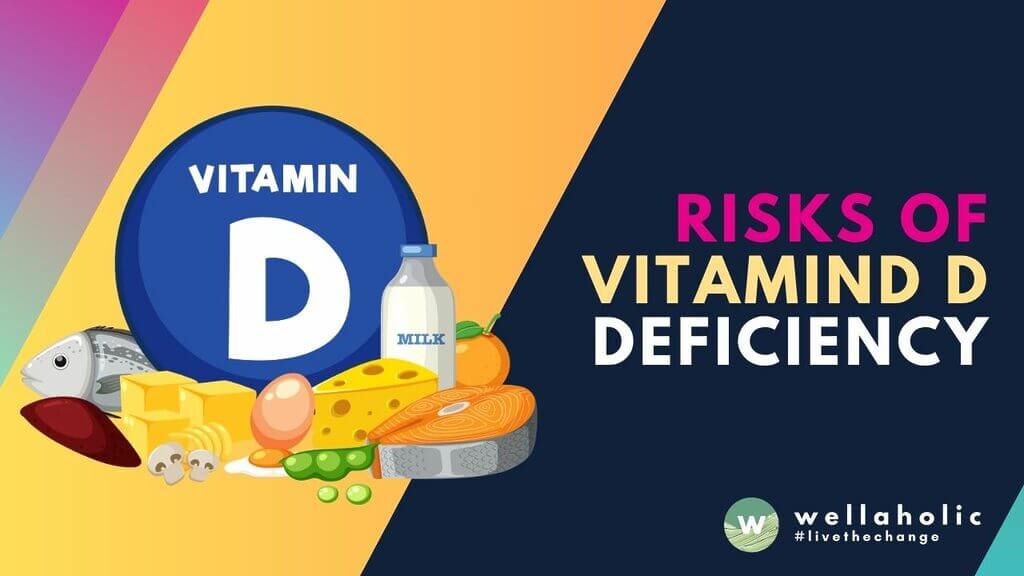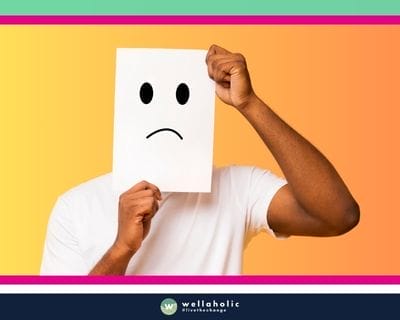
The Surprising Danger of Vitamin D Deficiency
A Serious Health Issue Why Vitamin D Deficiency is a Concern ☀️
Key Facts & Common Symptoms 📊
Fatigue
Persistent Tiredness
Bone Pain
Aches & Weakness
Hair Loss
Noticed Thinning
Depression
Changes in Mood
The Serious Health Impacts
🔵 **Weakened Bones:** Vitamin D is crucial for absorbing calcium and building strong bones.
🔵 **Impaired Immune System:** A healthy level of Vitamin D can help your body fight off illness.
🔵 **Increased Disease Risk:** Studies link low Vitamin D to a higher risk of heart disease, diabetes, and certain cancers.
Take a step towards better health and wellness.

Did you know that despite Singapore’s year-round sunshine, nearly half of us still suffer from vitamin D deficiency?
This shocking reality affects our bone health, immune system, and overall well-being in ways we never imagined. At Wellaholic, we’ve helped thousands of customers across Singapore understand their health needs through our comprehensive wellness services over the past decade.
In this article, we’ll explore what vitamin D deficiency really means, uncover the hidden health risks you might be missing, examine why this problem is so common in our tropical climate, and share proven strategies to boost your vitamin D levels effectively. You’ll discover practical solutions backed by local health data and expert recommendations.

What is Vitamin D Deficiency and Why Does it Matter?
The Two Types of Vitamin D Your Body Needs
We often hear about vitamin D, but many people don’t realize there are actually two main types our bodies use. Vitamin D2 comes from plant sources and fortified foods like cereals and milk. Vitamin D3 is what our skin produces when exposed to sunlight, and it’s also found in fatty fish and egg yolks. At Wellaholic, we’ve noticed that many customers in Singapore focus only on sun exposure but miss the importance of dietary sources. Both types work together to keep our bones strong and our immune system healthy.
How Your Body Actually Produces Vitamin D
The process of making vitamin D is quite amazing. When UVB rays from the sun hit our skin, they trigger a chemical reaction that creates vitamin D3. This then travels to our liver and kidneys, where it transforms into the active form our body can use. However, this process can be blocked by factors like sunscreen, clothing, or even spending too much time indoors. We see this challenge daily with our customers who work in Singapore’s many office buildings and shopping centers.
Singapore’s Surprising Deficiency Statistics
Here’s what shocked us most: despite our tropical climate, studies show that 42% of healthy Singaporeans have vitamin D deficiency. Even more concerning, during the pandemic, 90% of pregnant women were found to be deficient. These numbers reveal that living in a sunny country doesn’t automatically protect us from this serious health issue.
Key Insight: Vitamin D deficiency affects nearly half of Singapore’s population, making it a widespread health concern that requires immediate attention.

The Silent Health Risks You Can’t Ignore
Early Warning Signs Most People Miss
We’ve learned that vitamin D deficiency is called the “silent epidemic” for good reason. The early symptoms are so common that most people dismiss them as normal stress or aging. Customers at Wellaholic often mention feeling constantly tired, having general body aches, or struggling with muscle weakness. These vague symptoms make it easy to ignore the problem until it becomes serious. What starts as difficulty climbing stairs or getting up from a chair can progress to chronic pain and mobility issues. The tricky part is that these signs develop slowly over months or years, making them hard to connect to vitamin D levels.
Serious Long-term Health Complications
When vitamin D deficiency goes untreated, the consequences become severe. Our bones start losing density, leading to conditions like osteomalacia in adults and rickets in children. We’ve seen how this affects families in Singapore, where children may develop delayed growth and dental problems. Adults face increased risk of fractures, especially in the spine, hips, and wrists. Beyond bone health, vitamin D deficiency weakens our immune system, making us more susceptible to infections and respiratory illnesses. Research shows that people with low vitamin D levels have higher rates of diabetes, heart disease, and even certain cancers.
Special Risks for Different Age Groups
Different life stages bring unique risks that we need to understand. Pregnant women with vitamin D deficiency may experience complications during pregnancy and delivery. Their babies can be born with low vitamin D stores, affecting early development. Elderly adults face the highest risk of falls and fractures due to muscle weakness and bone fragility. In Singapore’s rehabilitation centers, studies found that 85.5% of elderly patients had vitamin D deficiency, highlighting how widespread this problem has become among our aging population.
Health Alert: Untreated vitamin D deficiency can lead to permanent bone damage, increased infection risk, and serious complications across all age groups.

The Surprising Reasons Behind Singapore’s Vitamin D Crisis
Indoor Lifestyle and Modern Work Patterns
We live in one of the world’s most urbanized cities, and this creates unexpected health challenges. Most of our customers at Wellaholic work in air-conditioned offices, shopping malls, or indoor facilities for 8-10 hours daily. Singapore’s PMET (Professional, Managerial, Executive, and Technical) workers spend up to 90% of their waking hours indoors. Even our commute happens through covered walkways and MRT tunnels. When we do go outside, we’re often rushing between buildings or staying in shaded areas to avoid the heat. This indoor lifestyle means our skin rarely gets the direct sunlight needed to produce vitamin D3, even though we live just one degree north of the equator.
Cultural and Ethnic Risk Factors
Singapore’s diverse population faces different levels of vitamin D deficiency risk. We’ve observed that people with darker skin pigmentation need more sun exposure to produce the same amount of vitamin D as those with lighter skin. Studies show that all Indian and Malay participants in local research were found to be vitamin D deficient. Cultural preferences also play a role – many of our customers actively avoid sun exposure to maintain fair skin, using umbrellas, long sleeves, and high-SPF sunscreen daily. These protective measures, while good for preventing skin damage, can block the UVB rays our bodies need for vitamin D production.
Pandemic Impact on Sun Exposure
The COVID-19 pandemic made Singapore’s vitamin D crisis even worse. During circuit breaker periods, we stayed indoors for weeks at a time. Work-from-home arrangements meant even less outdoor time than usual. Parks and beaches were closed, eliminating our main opportunities for safe sun exposure. The result was dramatic – vitamin D deficiency rates among pregnant women jumped to 90% during this period. Even now, many people have maintained more indoor-focused lifestyles, continuing this concerning trend.
Reality Check: Singapore’s modern lifestyle, combined with cultural factors and recent pandemic restrictions, has created a perfect storm for widespread vitamin D deficiency.

Effective Strategies to Boost Your Vitamin D Levels
Smart Sun Exposure Guidelines for Singapore
We know that getting the right amount of sun in Singapore requires careful planning. The Health Promotion Board recommends 5-30 minutes of sun exposure twice weekly, ideally between 7-9 AM or after 5 PM when UV rays are less intense. At Wellaholic, we advise our customers to expose their arms and legs without sunscreen during these safe windows. The key is finding the balance – enough exposure to trigger vitamin D production without risking sunburn or skin damage. Even 10-15 minutes of morning sunlight while walking to work or exercising outdoors can make a significant difference. We suggest starting with shorter periods and gradually increasing exposure time based on your skin type and comfort level.
Dietary Sources and Supplementation Options
Food sources become crucial when sun exposure isn’t enough. We recommend incorporating fatty fish like salmon, mackerel, and sardines into your weekly meals. Egg yolks from free-range chickens, fortified milk, and cereals also provide valuable vitamin D2. However, getting adequate amounts through food alone is challenging in Singapore’s context. Many of our customers benefit from vitamin D3 supplements, especially during periods of limited sun exposure. Studies show that 4,000 IU daily supplementation can effectively correct deficiency and reduce diabetes risk in deficient individuals. Always consult healthcare professionals before starting any supplement regimen.
When to Seek Professional Help
We encourage regular health screenings, particularly for high-risk groups including pregnant women, elderly adults, and people with darker skin tones. Blood tests measuring 25-hydroxyvitamin D levels can accurately diagnose deficiency. If you experience persistent fatigue, muscle weakness, bone pain, or frequent infections, these could be signs requiring professional evaluation. Early detection and treatment prevent serious complications and improve quality of life significantly.

Conclusion
Vitamin D deficiency is a serious health issue that affects nearly half of Singapore’s population, despite our tropical climate and year-round sunshine. We’ve explored how this “silent epidemic” develops through our indoor lifestyles, cultural preferences, and modern work patterns, leading to symptoms that range from fatigue and muscle weakness to serious bone complications and immune system problems. The good news is that vitamin D deficiency is entirely preventable and treatable through smart sun exposure, dietary improvements, and professional guidance when needed. At Wellaholic, we’ve seen how education and awareness can transform our customers’ health outcomes.
By understanding the risks, recognizing the symptoms, and taking proactive steps to maintain optimal vitamin D levels, you can protect yourself and your family from this widespread but manageable health concern. Take action today – your bones, immune system, and overall well-being depend on it.
Key Takeaways
- Nearly 42% of healthy Singaporeans are vitamin D deficient despite living in a tropical climate, making regular screening essential for early detection
- Vitamin D deficiency causes serious health complications including bone weakness, immune system problems, and increased risk of fractures, particularly in elderly adults
- Indoor lifestyles and cultural sun-avoidance practices are the primary causes of vitamin D deficiency in Singapore’s urban population.
- Combining 5-30 minutes of safe sun exposure twice weekly with vitamin D-rich foods and professional supplementation guidance can effectively prevent and treat deficiency.
Frequently Asked Questions (FAQ)
How do I know if I have vitamin D deficiency?
Vitamin D deficiency often presents with vague symptoms that many people dismiss as normal stress or aging. The most reliable way to diagnose deficiency is through a blood test measuring 25-hydroxyvitamin D levels, with concentrations below 50 nmol/l indicating deficiency. At Wellaholic, we encourage our customers to pay attention to persistent symptoms and seek professional testing, especially if they belong to high-risk groups. Early detection prevents serious complications and improves treatment outcomes significantly.
🔵 Persistent fatigue and general weakness that doesn’t improve with rest
🔵 Muscle weakness, especially difficulty climbing stairs or rising from chairs
🔵 Bone pain in ribs, shins, lower back, or hips
🔵 Frequent infections or slow healing wounds
🔵 Depression, mood changes, or cognitive difficulties
🔵 Hair loss, brittle nails, or dental problems
What’s the difference between vitamin D2 and vitamin D3?
Vitamin D2 and D3 are the two main forms of vitamin D that our bodies use, but they come from different sources and have varying effectiveness. Vitamin D2 (ergocalciferol) comes from plant sources and fortified foods like cereals and milk, while vitamin D3 (cholecalciferol) is produced by our skin when exposed to UVB sunlight and found in animal products like fatty fish and egg yolks. Research shows that vitamin D3 is more effective at raising and maintaining blood levels of vitamin D. At Wellaholic, we help our customers understand that both types are important, but vitamin D3 from sunlight and supplements tends to be more potent for correcting deficiency.
🔵 Vitamin D2 comes from plant sources and fortified foods
🔵 Vitamin D3 is produced by skin exposure to sunlight and found in animal products
🔵 Vitamin D3 is more effective at raising blood vitamin D levels
🔵 Both types undergo the same conversion process in liver and kidneys
🔵 Supplements typically contain vitamin D3 for better absorption
🔵 Combining both dietary sources provides optimal vitamin D intake
What serious health problems can vitamin D deficiency cause?
Vitamin D deficiency leads to a cascade of health problems that extend far beyond bone health. When vitamin D levels are low, your body cannot properly absorb calcium, leading to bone weakness, osteomalacia in adults, and rickets in children. The deficiency also compromises immune function, making you more susceptible to infections and respiratory illnesses. At Wellaholic, we’ve observed how customers with untreated deficiency often experience multiple health issues simultaneously, emphasizing the importance of early intervention and comprehensive treatment approaches.
🔵 Osteomalacia (soft bones) in adults and rickets in children
🔵 Increased risk of fractures, especially in spine, hips, and wrists
🔵 Weakened immune system leading to frequent infections
🔵 Higher risk of cardiovascular disease and type 2 diabetes
🔵 Depression, cognitive decline, and mood disorders
🔵 Muscle weakness and increased fall risk in elderly adults
Can vitamin D deficiency affect my immune system?
Vitamin D plays a crucial role in immune system function, and deficiency significantly compromises your body’s ability to fight infections. Vitamin D receptors exist throughout your immune system, helping regulate both innate and adaptive immune responses. When levels are low, your white blood cells cannot function optimally, making you more susceptible to respiratory infections, flu, and other illnesses. At Wellaholic, we’ve noticed that customers who address their vitamin D deficiency often report fewer sick days and faster recovery from illnesses, highlighting the vitamin’s importance for overall health resilience.
🔵 Vitamin D receptors are present throughout the immune system
🔵 Deficiency increases susceptibility to respiratory infections and flu
🔵 Low levels impair white blood cell function and antibody production
🔵 Adequate vitamin D helps regulate inflammatory responses
🔵 Supplementation can reduce frequency and severity of infections
🔵 Immune benefits are most pronounced in deficient individuals
How long does it take to correct vitamin D deficiency?
The timeline for correcting vitamin D deficiency varies depending on the severity of deficiency and the treatment approach used. With proper supplementation (typically 4,000 IU daily for deficient individuals), blood levels usually begin improving within 4-6 weeks, with optimal levels achieved in 2-3 months. However, it may take 6-12 months to fully replenish body stores and see maximum health benefits. At Wellaholic, we advise our customers that consistency is key – regular supplementation combined with lifestyle changes provides the best long-term results and prevents recurrence of deficiency.
🔵 Blood levels begin improving within 4-6 weeks of proper supplementation
🔵 Optimal vitamin D levels typically achieved in 2-3 months
🔵 Full body store replenishment may take 6-12 months
🔵 Symptom improvement often occurs before blood levels normalize
🔵 Regular monitoring ensures treatment effectiveness and safety
🔵 Maintenance therapy prevents recurrence of deficiency
What happens if I don’t treat my vitamin D deficiency?
Untreated vitamin D deficiency progressively worsens over time, leading to increasingly serious health complications
. Initially, you may experience fatigue and muscle weakness, but prolonged deficiency can result in permanent bone damage, increased fracture risk, and severe mobility limitations. The condition also increases your risk of developing chronic diseases including diabetes, cardiovascular disease, and certain cancers. At Wellaholic, we emphasize that vitamin D deficiency is completely preventable and treatable – the key is taking action before irreversible damage occurs to your bones and overall health.
🔵 Progressive bone weakness leading to osteomalacia or osteoporosis
🔵 Increased risk of fractures, particularly in spine and hips
🔵 Permanent mobility limitations and increased fall risk
🔵 Higher likelihood of developing diabetes and heart disease
🔵 Compromised immune function and frequent infections
🔵 Potential complications during pregnancy and childbirth

Serene Chiam, Aesthetic Director (LinkedIn)
Serene Chiam is the highly skilled Aesthetic Director at Wellaholic, Singapore’s premier aesthetic chain. With over a decade of expertise in the aesthetics industry, Serene brings a wealth of knowledge and experience to her role. She previously served as a Clinical Aesthetics Manager with Laser Clinics Australia, honing her skills in laser hair removal and other advanced treatments. Serene holds a CIDESCO certificate in skincare and a Bachelor of Health Science (Aesthetics) from Torrens University, Australia. Her deep understanding of the latest aesthetic technologies and techniques ensures that Wellaholic’s clients receive the most effective, long-lasting hair removal results. Serene’s passion for helping others feel confident and beautiful shines through in her dedication to providing exceptional care and achieving optimal outcomes for every client.
Contact Serene at serene@wellaholic.com
Wellaholic – Our Vision and Brand Promise

Wellaholic Vision and Brand Promise
At Wellaholic, we have a clear vision and brand promise that drives our dedication to helping customers look their best and achieve their aesthetic goals. We strive to provide exceptional service, foster a positive community, and empower our customers to prioritize self-care and embrace a healthier, happier lifestyle.
Wellaholic – Our Value Proposition
1. Affordable Prices. Always

- ⭐ Economical Excellence. Wellaholic maintains affordability through low costs, offering unlimited pricing packages to customers.
- ⭐ Smart Locations. Wellaholic places outlets near city MRT stations, avoiding high rents and passing savings to customers.
- ⭐ Competitive Insight. Through periodic surveys, Wellaholic ensures its prices remain affordable and competitive.
2. Highly Trained Staff

- ⭐ Commitment to Quality. Wellaholic continually trains staff, ensuring consistent, high-level service.
- ⭐ Expert Team. Wellaholic’s friendly staff boasts extensive skills and experience, including CIDESCO and WSQ qualifications.
- ⭐ Inclusive Excellence. Regular training audits at Wellaholic ensure consistent, high-quality treatments for all skin types.
3. Easy Online Booking

- ⭐ Efficient Scheduling. Wellaholic’s advanced booking system enables real-time tracking of customer appointments.
- ⭐ No-Wait Convenience. Wellaholic’s efficient booking system offers 24/7 access to schedule your preferred slot.
- ⭐ Easy Customization. Choose outlet, consultant, and service with a few clicks for personalized Wellaholic experience.
4. Multiple Convenience Locations

- ⭐ Convenient Expansion. Wellaholic will keep opening outlets in strategic locations, catering to customer convenience.
- ⭐ Accessible Proximity. Wellaholic outlets are within a 5-minute walk from multiple MRT lines for easy accessibility.
- ⭐ Expanded Capacity. Wellaholic’s ongoing expansion guarantees ample availability to meet customer demands effectively.
5. We are Open Everyday

- ⭐ Convenient Hours. Wellaholic operates from 11AM to 10PM on weekdays and 11AM to 8PM on weekends and holidays.
- ⭐ After-Work Flexibility. Wellaholic acknowledges the need for treatments after work, accommodating customer schedules accordingly.
- ⭐ Weekend Availability. Wellaholic understands customers’ weekend constraints and strives to open almost every day to accommodate them.
Reason 1: Wellaholic’s Unlimited Plans Save You Money
- ✅ Unlimited Hair Removal. Wellaholic offers unlimited hair removal plans with unlimited shots.
- ✅ Pay One Price for All Body Parts. Customers pay one price for unlimited hair removal on all body parts.
- ✅ Huge Cost Savings. Huge cost savings with unlimited plan. No separate fees for different body parts.

Reason 2: Wellaholic Has Over 50 Awards and 2000 Genuine Customer Reviews
- ✅ Over 50 Awards. Wellaholic’s treatments have been recognized by top beauty publications such as Daily Vanity, Beauty Insider
- ✅ Over 2000 Verified Customer Reviews. Wellaholic has over 2000 positive reviews from customers around the world.
- ✅ Over 50% Repeat Customers. More than 50% of Wellaholic’s customers are repeat and recurring customers.

Reason 3: It’s Easy to Book an Appointment at Wellaholic
- ✅ Open 361 Days Per Year. Wellaholic’s 8 outlets are open 361 days a year, including public holidays for easy bookings.
- ✅ No Queues. Book appointments in advance to avoid long wait times.
- ✅ Easy Online Booking. Customers can conveniently book and reschedule appointments online.
- ✅ No Extra Cost for Choosing Consultant. Customers can choose their preferred consultant for free.






